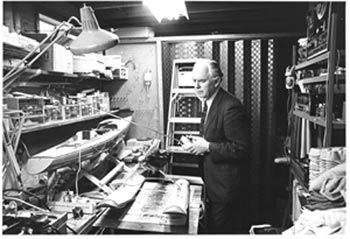Belding Scribner, MD: dialysis pioneer and patient advocate
By Kate Ramsayer
Photo by Gary Cavalli
 |
|
The death of one patient inspired Belding Scribner, MD, to invent a device that would save over a million people. Scribner, class of 1945, died in June at 82.
In December 1959, Scribner treated a man suffering from renal failure with a temporary artificial kidney machine. The medical team could only perform blood-cleansing dialysis a few times, however, as the procedure required cutting open vessels to tap into the bloodstream and physicians soon exhausted intact vessels. Although the patient appeared better, his kidneys deteriorated and the doctors sent him home to die. Scribner was still thinking about the case weeks later when an insight came to him in the middle of the night that would allow repeated access to blood vessels.
With University of Washington surgeon David Dillard, MD, and engineer Wayne Quinton, Scribner designed a shunt made from Teflon, a new non-stick material they thought was less likely to cause clots. The ends of the U-shaped device were sewn into a vein or artery, while the curved part stuck out from the patient’s arm or leg and could be removed multiple times for easy access to the blood. The first patient was treated with a “Scribner shunt” in March 1960 and lived for 11 years.
“Suddenly we took something that was 100 percent fatal and overnight turned it into 90 percent survival,” Scribner told Stanford MD in 1974.
Scribner was born in Chicago in 1921, and as a child with asthma grew
interested in medicine. After graduating from UC-Berkeley, he attended
Stanford medical school. “I liked what I’d heard about Stanford,” Scribner
told Stanford MD. “It turned out to be the most crucial decision
I ever made, because I wouldn’t have had the freedom of action
at Harvard that I did at Stanford.” Scribner joined the University
of Washington faculty in 1951 and remained there for his career.
While much attention and funds were focused on basic nephrology research, Scribner
was interested in practical issues, recalls Roy Maffly, MD, founder and former
co-chair of Stanford’s nephrology division. And with the invention of
the shunt, Scribner revolutionized the treatment of kidney disease. “There
were no options,” says Maffly. “People would die of chronic renal
failures and you could do little about it.” Maffly remembers a meeting
when Scribner first presented his findings. “It was phenomenal,” says
Maffly. “After he gave his talk, the audience, doctors of all specialties,
got up and gave him a standing ovation.”
For about a decade, however, financial constraints meant only a few dialysis centers offered treatment. Too many patients vying for too few beds led to what many consider the beginning of medical ethics as a field of inquiry, says Jeffry Young, MD, a fellow under Scribner and now chief of the division of nephrology at Santa Clara Valley Medical Center. In Seattle, four committees determined who had access to the limited resource. The medical committee ensured patients were otherwise healthy; the psychological committee evaluated their ability to handle the emotional stresses; and the financial committee confirmed that patients had at least $30,000 to cover three years of treatment. The admissions advisory committee, sometimes referred to as the “Life or Death Committee,” was the final obstacle. It consisted of a banker, surgeon, lawyer, minister, labor leader, housewife and government official and examined the personal lives and community involvement of the remaining applicants and essentially determined who was worth saving.
“It was a big controversy — how do you decide who gets to live? Who do you pick?” says Maffly.
When Medicare began covering chronic dialysis in 1972, for-profit institutions sprung up to offer the treatment. Scribner turned down positions with these organizations, remembers Young. “Scribner took on the for-profits because he was first and foremost the patient’s advocate,” says Young. “He really loathed all of what he considered to be the abuse of the technology to make a big profit.” Scribner also became an advocate for more convenient and less costly home dialysis treatments, which he helped develop when a 16-year-old girl was rejected by the advisory committee.
In his role as teacher Scribner was known as dedicated and effective. He compiled a packet of nephrology cases for the fellows to study, then made them explain the cases to medical students. “He was an excellent teacher,” recalls Young, who worked with Scribner in the late 1970s. “We learned better because we were teaching as well.”
Scribner commuted to work from his houseboat by canoe until repeated thefts forced him to switch to an old motorboat, his wife, Ethel, says. He built and bought model airplanes and boats and collected Bordeaux wines – a hobby that got him in trouble in the 1960s when officials confiscated a collection he had imported without declaring it to the state. He was allowed to buy the wines back, after paying the tax, and later auctioned some off to benefit an endowed chair in his name at the university. Washington’s strict wine laws were relaxed soon after, in part because of the publicity over Scribner’s predicament.
In 2002, Scribner and Willem Kolff, MD, the University of Utah inventor of the artificial kidney, shared the Albert Lasker Award for Clinical Medical Research. Scribner’s medical inventions weren’t limited to renal care; he also developed an artificial gut that allowed patients to receive nutrition through their bloodstream. Scribner’s wife says before his death, he was working on an advice book for patients on the brink of developing kidney problems. He was also attempting to convince dialysis centers to increase the length of treatments, which he felt were being shortened to cut costs.
Scribner drowned June 19, 2003, after apparently falling from his houseboat. In addition to his wife, he is survived by four children, three stepchildren, multiple grandchildren and by friends and colleagues in nephrology. Says Young: “Once you met Scrib, he became a friend for life.” SMD

